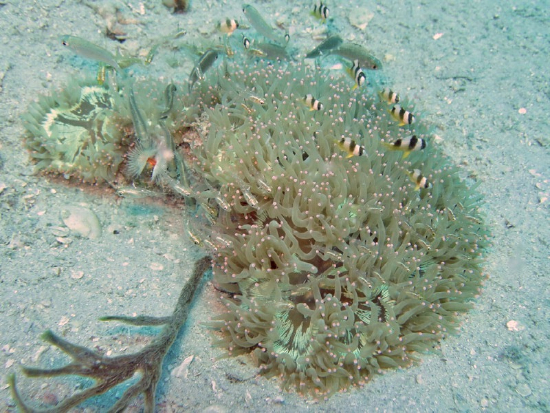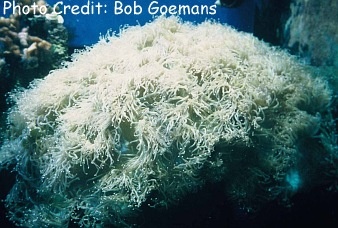
By Bob Goemans

Likely Reef Tank Suitable
Likely Fish-Only Tank Suitable
Range: Indo-West Pacific Ocean: East Coast of Africa to the Great Barrier Reef.
Natural Environment: Inhabits a wide assortment of protected environments, e.g., mud and/or sandy substrates/lagoons, seagrass beds, deep reef slopes, muddy banks, etc., with their skeleton deeply imbedded in the sediment and can be seen down to depths of about 130 feet (40 m).
General Husbandry: Somewhat common in the trade/Maricultured specimens available.
Care should be taken as to its position, with soft bottom areas preferred in the aquarium, as this species is aggressive and can damage downstream neighbors with tentacles that can extend outwards about 4 inches (10 cm).
Somewhat capable of producing its nutritional needs via photosynthesis, yet benefits from once or twice a week feedings of various plankton-like foods, such as Oyster eggs, cyclops, baby brine shrimp, Spirulina, enriched adult brine and mysis shrimp,
This multi-mouth single polyp animal is almost always extended with free flowing tentacles. Some specimens have pink tipped tentacles and others have white or purple tips. The fleshy polyp is usually various shades of intense green, which is the pigment that provides its ultraviolet protection. Even though found in a variety of shapes and colors, they all belong to a single species.
Taxonomy:
Kingdom: Animalia
Phylum: Cnidaria
Class: Anthozoa
Subclass: Hexacorallia
Order: Scleractinia
Family: Euphyllidae
Genus: Caryophyllia
FYI: When purchasing a specimen with highly inflated flesh, do not remove it from the water as the weight of the water in the flesh may damage or tear the flesh. Gently shake the specimen and allow the flesh to retract somewhat before removing.
Some aquarists may experience an allergic reaction if they are stung.
Recommend much caution if housed with Anemonefishes! They may tend to use its large polyp as they would an anemone and that would stress the coral causing it to possibly stay closed/unable to feed.
Photo of this species in the wild is provided free via the courtesy of Wikimedia.
Experience Level: Intermediate
Diet: Photosynthetic/Plankton feeder
Temperament: Aggressive
Aquarium Environment: Reef or fish-only aquarium
Coral Safe: With caution
Fish Safe: Yes
Invertebrate Safe: Yes
Acclimation Time: 30 minutes+
Aquarium Hardiness: Moderate
Calcium (Ca): 380 - 430 mg/l
Alkalinity: 2.5 - 3.0 meq/l
Phosphate (PO4): <0.05 mg/l
Magnesium (Mg): approx. 1350 mg/l (relate to specific gravity)
Strontium (Sr) 8 - 10 mg/l
Temperature Range: 72 - 82°F (22 - 27°C)
Minimum Tank Size: 30 gallons
Lighting: PAR 250 - 350+
Water Movement: WM 1 - 2
Specific Gravity: 1.023 - 1.025
pH: 8.0 - 8.4
Iodine/Trace Elements Monitor/as necessary to maintain quality seawater.

